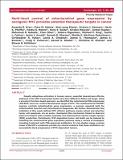| dc.contributor.author | Oran, Amanda R. | en_US |
| dc.contributor.author | Adams, Clare M. | en_US |
| dc.contributor.author | Zhang, Xiao-yong | en_US |
| dc.contributor.author | Gennaro, Victoria J. | en_US |
| dc.contributor.author | Pfeiffer, Harla K. | en_US |
| dc.contributor.author | Mellert, Hestia S. | en_US |
| dc.contributor.author | Seidel, Hans E. | en_US |
| dc.contributor.author | Mascioli, Kirsten | en_US |
| dc.contributor.author | Kaplan, Jordan | en_US |
| dc.contributor.author | Gaballa, Mahmoud R. | en_US |
| dc.contributor.author | Shen, Chen | en_US |
| dc.contributor.author | Rigoutsos, Isidore | en_US |
| dc.contributor.author | King, Michael P. | en_US |
| dc.contributor.author | Cotney, Justin L. | en_US |
| dc.contributor.author | Arnold, Jamie J. | en_US |
| dc.contributor.author | Sharma, Suresh D. | en_US |
| dc.contributor.author | Martinez, Ubaldo E. | en_US |
| dc.contributor.author | Vakoc, Christopher R. | en_US |
| dc.contributor.author | Chodosh, Lewis A. | en_US |
| dc.contributor.author | Thompson, James E. | en_US |
| dc.contributor.author | Bradner, James E. | en_US |
| dc.contributor.author | Cameron, Craig E. | en_US |
| dc.contributor.author | Shadel, Gerald S. | en_US |
| dc.contributor.author | Eischen, Christine M. | en_US |
| dc.contributor.author | McMahon, Steven B. | en_US |
| dc.date.accessioned | 2017-04-06T03:18:47Z | |
| dc.date.issued | 2016 | en_US |
| dc.identifier.citation | Oran, A. R., C. M. Adams, X. Zhang, V. J. Gennaro, H. K. Pfeiffer, H. S. Mellert, H. E. Seidel, et al. 2016. “Multi-focal control of mitochondrial gene expression by oncogenic MYC provides potential therapeutic targets in cancer.” Oncotarget 7 (45): 72395-72414. doi:10.18632/oncotarget.11718. http://dx.doi.org/10.18632/oncotarget.11718. | en |
| dc.identifier.issn | | en |
| dc.identifier.uri | http://nrs.harvard.edu/urn-3:HUL.InstRepos:32071988 | |
| dc.description.abstract | Despite ubiquitous activation in human cancer, essential downstream effector pathways of the MYC transcription factor have been difficult to define and target. Using a structure/function-based approach, we identified the mitochondrial RNA polymerase (POLRMT) locus as a critical downstream target of MYC. The multifunctional POLRMT enzyme controls mitochondrial gene expression, a process required both for mitochondrial function and mitochondrial biogenesis. We further demonstrate that inhibition of this newly defined MYC effector pathway causes robust and selective tumor cell apoptosis, via an acute, checkpoint-like mechanism linked to aberrant electron transport chain complex assembly and mitochondrial reactive oxygen species (ROS) production. Fortuitously, MYC-dependent tumor cell death can be induced by inhibiting the mitochondrial gene expression pathway using a variety of strategies, including treatment with FDA-approved antibiotics. In vivo studies using a mouse model of Burkitt's Lymphoma provide pre-clinical evidence that these antibiotics can successfully block progression of MYC-dependent tumors. | en |
| dc.language.iso | en_US | en |
| dc.publisher | Impact Journals LLC | en |
| dc.relation.isversionof | doi:10.18632/oncotarget.11718 | en |
| dc.relation.hasversion | http://www.ncbi.nlm.nih.gov/pmc/articles/PMC5340124/pdf/ | en |
| dash.license | LAA | en_US |
| dc.subject | MYC | en |
| dc.subject | mitochondria | en |
| dc.subject | mitochondrial gene expression | en |
| dc.subject | tigecycline | en |
| dc.subject | synthetic lethality | en |
| dc.title | Multi-focal control of mitochondrial gene expression by oncogenic MYC provides potential therapeutic targets in cancer | en |
| dc.type | Journal Article | en_US |
| dc.description.version | Version of Record | en |
| dc.relation.journal | Oncotarget | en |
| dash.depositing.author | Bradner, James E. | en_US |
| dc.date.available | 2017-04-06T03:18:47Z | |
| dc.identifier.doi | 10.18632/oncotarget.11718 | * |
| dash.authorsordered | false | |
| dash.contributor.affiliated | Bradner, James E | |


